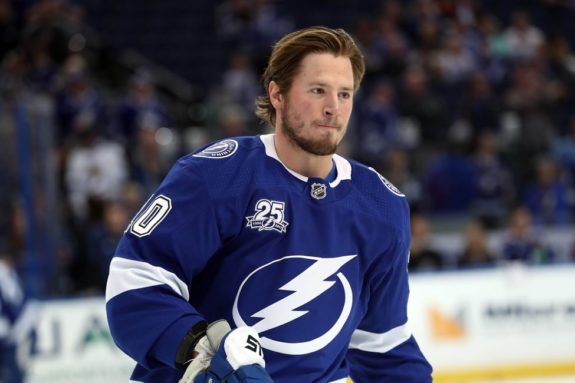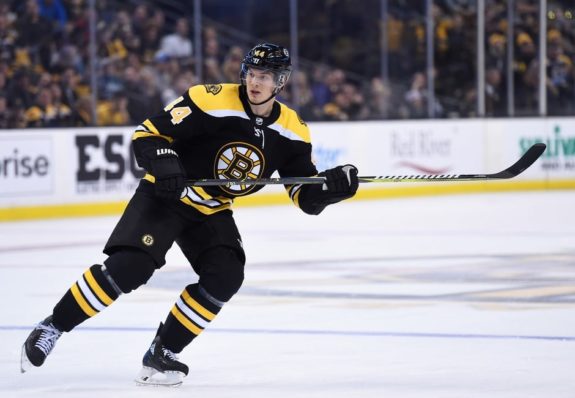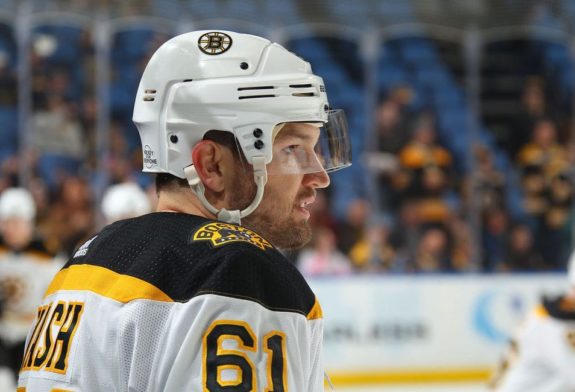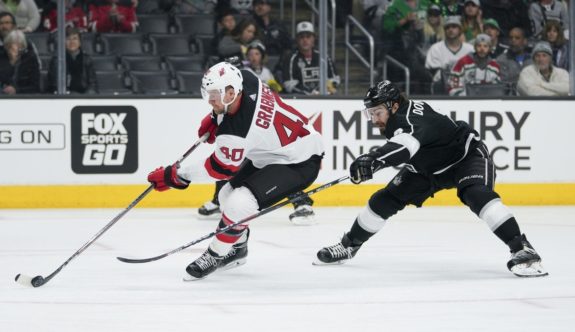As the players dealt by the New York Rangers at the 2017-18 NHL trade deadline are eliminated from the playoffs, let’s take a look at the bang-for-the-buck that the other teams got in players and prospects. The Rangers dealt with three teams at the deadline, making four significant deals that sent five Rangers to playoff-bound teams.
They received, in return, four players with NHL experience, four prospects and six draft picks. Here’s a ‘value countdown’ towards the biggest steal. We’ll be considering the cost of the acquisition and the post-trade performance of the players involved.
All right, let’s do this countdown thing…
#4 Lighting Acquire Another Rangers Captain
To the Rangers: Vladislav Namestnikov, Libor Hajek, Brett Howden, 2018 first-round pick, 2019 conditional second-round pick
To Lightning: Ryan McDonagh, J.T. Miller
It should come as little surprise that the deal with the most unresolved trade value involves the only team that still has hopes of winning a Stanley Cup this season.
While the Tampa Bay Lightning are down 0-2 in their best-of-seven series against the Washington Capitals, the potential value they received from dealing for Rangers’ former captain McDonagh and Miller extends past this season. McDonagh has another year on his deal, while Miller will be a Restricted Free Agent (RFA) on July 1 of this year.

For their value, the Lightning paid the most of the teams that dealt with the Rangers at the deadline. While Namestnikov’s brief audition with the Blueshirts fell flat, the primary value of the deal was in the prospects and picks the Rangers received.
Both Hajek and Howden project to be middle tier NHLers – something that the Rangers desperately need in their development system during their rebuild. The first-round pick will be towards the end of the round, but a condition of the deal states that should Tampa win the Cup this year or next, the second-round pick in 2019 would become a first-round pick.
So far, McDonagh and Miller have performed well for the Bolts and have filled the roles for which they were acquired. McDonagh has bolstered the defensive depth as a minutes-munching shutdown partner. He had three points in 14 regular season games and has added five assists in 12 playoff contests, averaging around 22 min. per game.
Miller has found himself on the top line alongside Steven Stamkos and Nikita Kucherov for much of his time with Tampa, and rewarded the coach’s decision with 18 points in 19 regular season games after the trade. Through 12 playoff games, he has regressed a bit with seven points.
Ultimately, the value in this deal will depend on a number of factors. If Hajek and Howden exceed expectations, the Rangers will be happy with the return they received. If one or both falter, general manager Jeff Gorton will have some egg on his face. If Tampa wins a Cup in the next two seasons, they won’t care what happens to the prospects they lost either way.
#3 Bruins Overpay for Depth Defender Nick Holden
To Rangers: Rob O’Gara, 2018 third-round pick
To Bruins: Nick Holden

The value dropoff is both swift and severe for teams that dealt with the Rangers outside of the Lightning. While the deal that sent Holden to Boston a few days prior to the deadline provided the smallest return to the Blueshirts, what Boston got in Holden was even less. On the surface, 18 regular season contests averaging 19 min. per game with five points is reasonable for a depth defenseman. However, the Bruins were not acquiring assets to reach the playoffs, they were looking to solidify their postseason chances.
Holden did next to nothing to improve their playoff run. He appeared in just two contests, averaging just under 12:30 per game as the Bruins were ousted in the second round by the Lightning in five games. He was barely-used depth for their blue line, falling behind Adam McQuaid and Matt Grzelcyk.
Thankfully for the Rangers, Boston wasn’t done dealing with them.
#2 Bruins Return to the Rangers Well for Rick Nash
To Rangers: Ryan Spooner, Matt Beleskey (50% retained salary), Ryan Lindgren, 2018 first-round pick, 2019 seventh-round pick
To Bruins: Rick Nash (50% retained salary)
Rangers fans are familiar with Nash’s propensity to create dynamic offensive chances that don’t result in goals. This trait was particularly troublesome for a team in the postseason where Nash, fairly or not, gained a reputation as a player who underperformed as the pressure rose. In recent playoff runs with the Rangers, Nash was beginning to shed that reputation with 19 points in his final 24 playoff games with the Rangers over the previous two seasons.

Perhaps that was why the Bruins were willing to pay a big haul for a former star player who had fallen to a 40-point regular season forward. In return, the Rangers received the 26th overall pick in the upcoming draft along with defensive prospect Lindgren. In what could be considered a side deal and salary dump, the Rangers also received Spooner and Beleskey.
Spooner is a 26-year-old center who will be an RFA at the conclusion of the season. He produced well for the Rangers as they closed out their season, with 16 points in 20 games. Beleskey passed through waivers when acquired and spent all but the final regular season game with the Hartford Wolf Pack of the AHL.
In hindsight, the deal was a poor management decision by the Bruins, considering their second-round exit. The Bruins got the “old” Nash for their playoff run. The talk among journalist and fans would be familiar to the Rangers’ faithful. Nash played consistently up and down the ice, was strong in the defensive zone and created a lot of chances offensively. If only he had finished more than just three times, with five total points, in 12 playoff games.
If only.
#1 Sticking it to the Devils
To Rangers: Yegor Rykov, 2018 second round pick
To Devils: Michael Grabner
The biggest disparity between what a team paid for a player versus what they received should make Rangers’ fans smile. It involved the first ever trade with their cross-town rival New Jersey Devils and regardless of how the pick and prospect turn out for the Blueshirts, it was a convincing win for them.

Leading up to the deadline, many in the Rangers community of professional writers and fans considered whether Grabner could fetch a first-round pick in what was shaping up to be a deep draft. In 59 games with the Rangers, Grabner scored 25 goals with virtually no power play time. While a handful of those goals were scored into an empty net, he was still very productive offensively. He was also among the fastest players in the league generating more than his fair share of breakaway attempts, and he was also a top penalty killer who’s speed kept opposing power plays honest.
Ultimately, he could not pry away a first-round pick, but the Rangers received a solid return, including a second-round selection and a good, 21-year-old defensive prospect already playing against men in the KHL, from a New Jersey team that wasn’t yet a lock to make the playoffs.
Grabner’s performance after the trade is what makes the value of this deal so low. Grabner would score just two goals and add three assists in 21 regular season games with the Devils and scored no points in two postseason games with the team, averaging around 10:30 min. per game. The Devils were bounced in the first round, 4-1, by the Lightning.